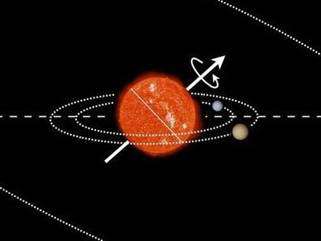Tilted suns

(Phys.org) —The Earth's axis of rotation is tilted 23.4 degrees to its orbital motion around the Sun (more precisely, its spin axis has a tilt of 23.4 degrees with respect to the axis of its orbit). This tilt, which causes our seasonal variations, was likely the result of a cataclysmic impact that occurred about 4.5 billion years ago between the Earth and another large body which probably also resulted in the formation of the moon. Such a large tilt is thought in general to result from a strong interaction between objects like the collision that formed the moon. Stars also spin, and their spin axes can also be tilted with respect to the orbits of their planets. In the case of our Sun, which spins roughly once every twenty-five days, its tilt is only 7.25 degrees, and so we never get a very good look at its north or south poles. Astronomers infer therefore that the Sun never had a traumatic encounter with another star (at least not since its planetary system formed, and at least not with a sudden collision).
The tilt of a star's spin is obviously an important feature, but knowing it first requires knowing the orbit of its planets. One amazing and serendipitous result of the Kepler mission and its powerful ability to find transiting planets is its ability - by characterizing planetary systems - to address the issue of stellar tilts. Stellar tilts measured so far in exoplanetary systems display a surprising diversity, from very small values like our Sun's to strongly tilted stars, and even some "retrograde" stars whose direction of rotation is opposite to the planetary orbital revolution. These stars also happen to be somewhat young; indeed most of the stars hosting planets in the Kepler program have not evolved past the hydrogen burning stage of their lives. Almost all of the tilted stars host hot Jupiters—planets about the mass of Jupiter (that is, large planets) but that orbit very close to the star and so are hot. The wide range of observed tilts suggests that they arose not from a standard sudden collision, but rather from some more intricate process that transports a normal Jupiter from its orbit far out (as in our solar system) to an orbit very close to the star.
CfA astronomers Josh Carter and Dave Latham, along with a team of collaborators, have found that the star known as Kepler-56 is the most evolved star observed by Kepler so far known to have more than one planet in its system. Kepler-56 is a red-giant star about 3.5 billion years old (it is now burning helium as fuel), has more than four times the diameter of the Sun, and is about 30% more massive. Its two planets, neither one a hot Jupiter, are much less massive with only about 22 and 181 Earth-masses, respectively. Notably, they orbit their star in nearly circular, coplanar orbits . It turns out that Kepler-56 is also tilted, and with a large angle of 47+-6 degrees. The result shows for the first time that the tilt of a star is not necessarily associated with the process of making hot Jupiters. What did tilt Kepler-56 is not yet known. The authors suggest that a third, distant massive companion, either a planet or another star, could be responsible, and indeed the data suggest the presence of such a third orbiting body. Additional observations are needed to confirm this conclusions, which already demonstrates the remarkable power of Kepler and the diversity of exoplanet systems.
More information: "Stellar Spin-Orbit Misalignment in a Multiplanet System," Daniel Huber, Joshua A. Carter, Mauro Barbieri, Andrea Miglio, Katherine M. Deck, Daniel C. Fabrycky, Benjamin T. Montet, Lars A. Buchhave, William J. Chaplin, Saskia Hekker, Josefina Montalbán, Roberto Sanchis-Ojeda, Sarbani Basu, Timothy R. Bedding, Tiago L. Campante, Jørgen Christensen-Dalsgaard, Yvonne P. Elsworth, Dennis Stello, Torben Arentoft, Eric B. Ford, Ronald L. Gilliland, Rasmus Handberg, Andrew W. Howard, Howard Isaacson, John Asher Johnson, Christoffer Karoff, Steven D. Kawaler, Hans Kjeldsen, David W. Latham, Mikkel N. Lund, Mia Lundkvist, Geoffrey W. Marcy, Travis S. Metcalfe, Victor Silva Aguirre, and Joshua N. Winn, Science, 2013
Journal information: Science
Provided by Harvard-Smithsonian Center for Astrophysics


















